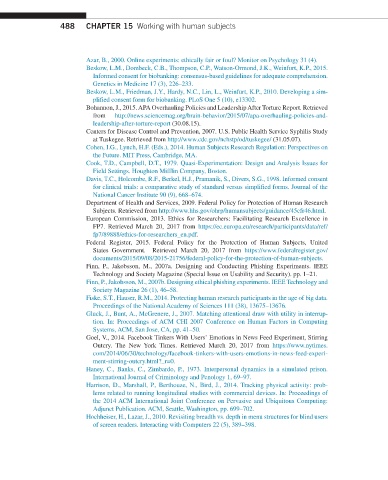Page 496 -
P. 496
488 CHAPTER 15 Working with human subjects
Azar, B., 2000. Online experiments: ethically fair or foul? Monitor on Psychology 31 (4).
Beskow, L.M., Dombeck, C.B., Thompson, C.P., Watson-Ormond, J.K., Weinfurt, K.P., 2015.
Informed consent for biobanking: consensus-based guidelines for adequate comprehension.
Genetics in Medicine 17 (3), 226–233.
Beskow, L.M., Friedman, J.Y., Hardy, N.C., Lin, L., Weinfurt, K.P., 2010. Developing a sim-
plified consent form for biobanking. PLoS One 5 (10), e13302.
Bohannon, J., 2015. APA Overhauling Policies and Leadership After Torture Report. Retrieved
from http://news.sciencemag.org/brain-behavior/2015/07/apa-overhauling-policies-and-
leadership-after-torture-report (30.08.15).
Centers for Disease Control and Prevention, 2007. U.S. Public Health Service Syphilis Study
at Tuskegee. Retrieved from http://www.cdc.gov/nchstp/od/tuskegee/ (31.05.07).
Cohen, I.G., Lynch, H.F. (Eds.), 2014. Human Subjects Research Regulation: Perspectives on
the Future. MIT Press, Cambridge, MA.
Cook, T.D., Campbell, D.T., 1979. Quasi-Experimentation: Design and Analysis Issues for
Field Settings. Houghton Mifflin Company, Boston.
Davis, T.C., Holcombe, R.F., Berkel, H.J., Pramanik, S., Divers, S.G., 1998. Informed consent
for clinical trials: a comparative study of standard versus simplified forms. Journal of the
National Cancer Institute 90 (9), 668–674.
Department of Health and Services, 2009. Federal Policy for Protection of Human Research
Subjects. Retrieved from http://www.hhs.gov/ohrp/humansubjects/guidance/45cfr46.html.
European Commission, 2013. Ethics for Researchers: Facilitating Research Excellence in
FP7. Retrieved March 20, 2017 from https://ec.europa.eu/research/participants/data/ref/
fp7/89888/ethics-for-researchers_en.pdf.
Federal Register, 2015. Federal Policy for the Protection of Human Subjects, United
States Government. Retrieved March 20, 2017 from https://www.federalregister.gov/
documents/2015/09/08/2015-21756/federal-policy-for-the-protection-of-human-subjects.
Finn, P., Jakobsson, M., 2007a. Designing and Conducting Phishing Experiments. IEEE
Technology and Society Magazine (Special Issue on Usability and Security). pp. 1–21.
Finn, P., Jakobsson, M., 2007b. Designing ethical phishing experiments. IEEE Technology and
Society Magazine 26 (1), 46–58.
Fiske, S.T., Hauser, R.M., 2014. Protecting human research participants in the age of big data.
Proceedings of the National Academy of Sciences 111 (38), 13675–13676.
Gluck, J., Bunt, A., McGrenere, J., 2007. Matching attentional draw with utility in interrup-
tion. In: Proceedings of ACM CHI 2007 Conference on Human Factors in Computing
Systems, ACM, San Jose, CA, pp. 41–50.
Goel, V., 2014. Facebook Tinkers With Users’ Emotions in News Feed Experiment, Stirring
Outcry. The New York Times. Retrieved March 20, 2017 from https://www.nytimes.
com/2014/06/30/technology/facebook-tinkers-with-users-emotions-in-news-feed-experi-
ment-stirring-outcry.html?_r=0.
Haney, C., Banks, C., Zimbardo, P., 1973. Interpersonal dynamics in a simulated prison.
International Journal of Criminology and Penology 1, 69–97.
Harrison, D., Marshall, P., Berthouze, N., Bird, J., 2014. Tracking physical activity: prob-
lems related to running longitudinal studies with commercial devices. In: Proceedings of
the 2014 ACM International Joint Conference on Pervasive and Ubiquitous Computing:
Adjunct Publication. ACM, Seattle, Washington, pp. 699–702.
Hochheiser, H., Lazar, J., 2010. Revisiting breadth vs. depth in menu structures for blind users
of screen readers. Interacting with Computers 22 (5), 389–398.

